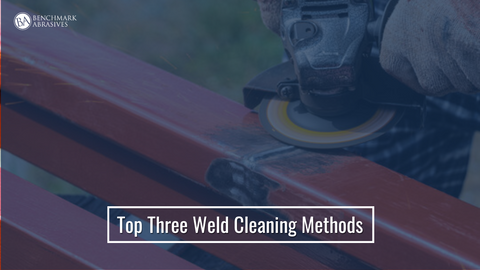
Top Three Weld Cleaning Methods

If welding is new to you, your welds aren't as neat as you had intended. It's likely not what you hoped to see, but you might see a dark or black mark surrounding the weld or, at best, a scale resembling a rainbow.
However, welding can result in discoloration and other surface flaws beyond aesthetic concerns. The stain is referred to as "hot tint." It resulted from welding at a high temperature, and the color change was brought on by the chromium oxide layer of the stainless steel being destroyed by heat. Without this layer, the steel is susceptible to corrosion and surface rust because it is protected from rust by it.
To maintain the steel's strength, form, and surface and to produce a long-lasting and appealing product, it is crucial to repair the stainless steel's anti-corrosion coating. You can achieve this by eliminating the heat tint and letting the chromium oxide layer rebuild.
Numerous approaches to accomplishing this include mechanical, chemical, and electrochemical. These techniques produce clean, polished metal workpieces, but each process takes a significantly different time and effort. Several of these techniques also cause surface damage, as we will explain later.
Top Three Weld Cleaning Methods
1. Mechanical Weld Cleaning
Because the tooling is affordable, mechanical weld cleaning is frequently used to remove heat tint from stainless steel workpieces. To remove the top layer, all that is necessary is to rub the surface with something more challenging than stainless steel.
The actual cleaning tool you use will depend on the project's demands and your preferences. For instance, wire brushes won't remove the base material or weld splatter, but abrasive goods like sandpapers or flat discs would. Flap discs work well for post-weld metal surface finishing and blending to prepare the metal surface for paint, primer, or powder coating. When welding hasn't done too much damage to the weld joints, wire brushes are a suitable choice for removing merely the heat tint, rust, and mill scale.
The aggressive approach, however, comes with additional expenses. Removing the stainless steel's surface with the abrasives damages the material's surface and leaves microscopic grooves behind. The damage can speed up corrosion and change the end product's appearance. The possibility of contamination is also present. When used on stainless steel after being previously used on carbon steel, abrasives embed iron particles into the surface, preventing the formation of chromium oxide and promoting corrosion.
The time-consuming nature of mechanical weld cleaning techniques may be a detriment to many organizations. You must have both talent and skill to polish your welds correctly. Last, using whirling or vibrating equipment can harm the user's health. There are often time restrictions on using such tools to reduce the risk of repetitive strain injuries.
2. Chemical Weld Cleaning
"Pickling paste" is the most typical product used for chemical weld cleaning. Rust, stains, and heat tint scale from metals are just a few examples of the surface contaminants it is exceptionally good at getting rid of.
The pickling paste may initially be relatively simple to use. All you have to do is use a spray or brush to apply the paste to the harmed regions, wait for it to interact with the metal, then scrape it off and neutralize the surface using a neutralizing agent. Unfortunately, the concentration of the past and the local temperature affect how long it takes to work. The length of the pickling process increases with "safer" picking practices and colder surroundings.
Pickling paste contains hazardous compounds like hydrofluoric and nitric acids, which should be noted. If exposed to the paste directly, these acids are exceedingly dangerous and can lead to long-term health issues like skin damage and acute lung injury. Of the three ways, this one has the most comprehensive PPE requirements for a good cause.
3. Electrochemical Weld Cleaning
One of the more recent weld cleaning techniques can be electrochemical weld cleaning. It is gradually becoming the quickest and safest alternative among the three weld cleaning techniques. For instance, to remove rust, surface contaminants, and heat tints, the TIG Brush, which invented a conductive brush, uses electrochemical cleaning. A significant benefit for projects where aesthetics are essential is that the electrochemical (or electrolytic) cleaning procedure may also make the metal workpiece smoother, shinier, and brighter.
The TIG Brush uses a conductive weld cleaning brush to administer a gentle electrolytic cleaning solution to welded joints or surfaces. An electric current is applied to speed up the cleaning and passivation process. Additionally, it has been demonstrated that the TIG Brush "passivates" the stainless steel's surface, giving it a stronger resistance to corrosion than other techniques. Added advantages include:
- Electrochemical cleaning is much less time-consuming than mechanical weld and pickling paste cleaning.
- When used with the advised PPE, electrochemical weld cleaning is safer for the user and the environment.
- Passivation happens while the weld is being cleaned; a subsequent step is not necessary to get this effect.
- There is no requirement to treat the entire metal surface; you can select the area to be treated.
- Because of its portability and increased versatility, you may use it anywhere.
- It is a cost-effective alternative for small to medium organizations because operating costs are relatively low.
THE BEST POST-WELD CLEANING TECHNIQUE
Electrochemical weld cleaning is the best option for all three weld cleaning techniques. It quickly, safely, and successfully cleans and passivates your metal parts. Check out the TIG Brush if you're searching for a more straightforward post-weld cleaning technique.
This instrument removes surface contaminants within minutes, eliminating the necessity for hazardous agents like pickling paste and time-consuming weld cleaning procedures. Dip the brush in cleaning fluid and swipe it across the weld to rapidly create a clean, passivated stainless steel surface.



































































